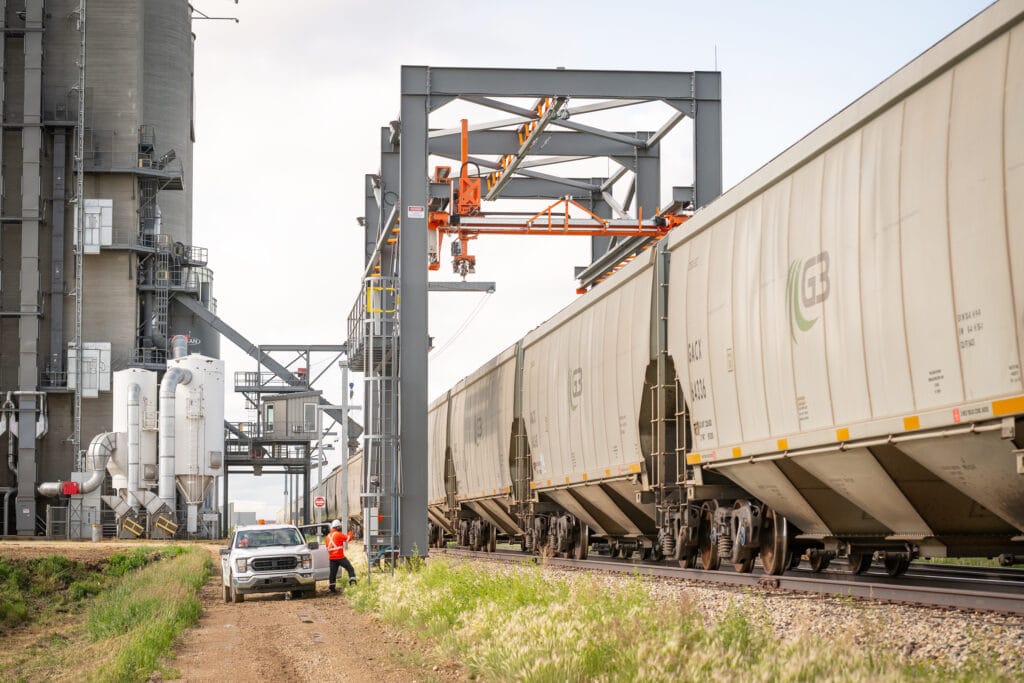Locally manufactured railcar solution key to strengthening provincial supply chain
In the heart of Saskatoon, a team of innovators is solving a problem the rail industry has quietly accepted for decades. Rayhawk has developed an autonomous system that eliminates the need to manually open and close railcar lids – a task historically performed by workers balancing on top of railcars in all weather conditions. It’s a safety breakthrough, an advancement in efficiency, and it’s proudly made in Saskatchewan.
“It was really kind of a fun experience to go through asking questions that nobody ever thought of asking,” President and CEO of Rayhawk Tom Boehm said. “There was an overwhelming interest in the market for a solution, but nobody had any idea how to solve the problem.”
The company’s story begins in late 2019 when Boehm was asked by a prospective client if the railcar loading process could be done without putting workers at risk. He started by sketching ideas on a whiteboard in his garage, as software and hardware concepts were evaluated. Over the next two years, the small but motivated team quietly developed and tested its technology inside a private research facility in Saskatoon. The company name came from the early prototype – a design with features resembling a hawk in flight – and also honours Boehm’s father, Ray, who once loaded railcars in Saskatchewan’s potash industry. By July 2021, the concept was ready to be released publicly.
Today, their autonomous system works on a bright orange gantry; a bridge-like overhead structure that spans the railcars. It incorporates sensors and vision recognition tools, as well as machine learning and artificial intelligence, to detect the different types of railcars.

The system can identify the position of a railcar, unlatch and open lids, inspect the interior of the car, and allows the railcar to be filled. It then closes the lid, ensuring safe transport of the product to a port facility, from where it is exported around the world. All without a single worker being put in harm’s way.
“We pride ourselves on the fact that it’s mechanically simple, yet computer complex,” Boehm explains. “We’re using vision recognition, we’re using radar systems, we’re using depth sensing. We’re training a model to recognize all the different things Mother Nature and the operating environment can throw at it.”
Plus, the system gets smarter every time it runs. Early adopters report that it’s performing with over 90 per cent accuracy and steadily increasing over time. Rayhawk’s customers include major players in Saskatchewan’s agriculture and mining sectors, like Nutrien and G3 Canada. Each have deployed the technology in a unique way.
At Nutrien’s Lanigan potash mine, a stationary system services railcars while they’re stopped beneath the gantry. G3’s Saskatoon West terminal handles and transports grain across Canada. Here, a loop-track design allows the technology to operate while railcars move continuously at a reduced speed beneath it. This is the most efficient way of loading railcars in the ag industry today.
Beyond reducing fall risks, the technology has helped address skilled labour shortages by enabling companies to redeploy staff into more meaningful, less hazardous roles. Support from workers has been strong, with many sharing personal stories of injuries or close calls in the past, and now offering ideas to make the system even better.
Boehm notes that the benefits of this innovative new technology also extend well beyond the job site. For an export-driven province like Saskatchewan, anything that moves product safely and efficiently strengthens the supply chain. By potentially reducing railcar standby and loading times from as much as 12 to 24 hours, to as little as six to eight, the system could help railway providers move trains faster. As a result, this improves efficiency, lowers costs, and increases the volume of product shipped using existing infrastructure.
The company’s key markets range from small grain terminals in rural North America to large mining producers that ship large quantities and volumes. This means the company is already pursuing international interest, particularly in the United States, but also looking towards agriculture-heavy regions like Australia, Mexico, and Argentina, in the future.
Rayhawk’s success is rooted in Saskatchewan’s strong technology sector and industrial talent, built through the province’s mining and agriculture industries. The company has also benefited from partnerships with the Saskatchewan Advantage Innovation Fund and Saskatchewan Trade and Export Partnership which have helped move the technology from whiteboard sketch to real-world use.
Saskatchewan’s innovation ecosystem that allows for the testing of new technologies, its competitive business environment, and the skilled workforce at its disposal, have created the ideal conditions for Rayhawk to grow and thrive.
As the province has become a national leader in advanced manufacturing, the company’s cutting-edge automated rail solution is one more example of how local innovation can make a global impact and contribute to Saskatchewan’s strong and resilient supply chain.
As they scale up, Boehm envisions their bright orange gantry becoming a familiar sight along rail lines across the province, Canada, and beyond – a quiet symbol of Saskatchewan ingenuity at work.
“Not too far away, you will be able to drive down every grid road and every highway in Saskatchewan and see a beautiful orange Rayhawk machine operating safely and efficiently and helping customers and shippers be their absolute best.”
For more information, contact:
Media Relations
Trade and Export Development
Regina
Phone: 306-526-6302
Email: media.ted@gov.sk.ca
